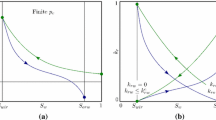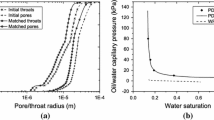Abstract
We present a dynamic pore-scale network model of imbibition, capable of calculating residual oil saturation for any given capillary number, viscosity ratio, contact angle, and aspect ratio. Our goal is not to predict the outcome of core floods, but rather to perform a sensitivity analysis of the above-mentioned parameters, except from the viscosity ratio. We find that contact angle, aspect ratio, and capillary number all have a significant influence on the competition between piston-like advance, leading to high recovery, and snap-off, causing oil entrapment. Due to significant CPU-time requirements we did not incorporate long-range correlations among pore and throat sizes in our network, but were limited to small-range correlations. Consequently, the gradual suppression of snap-off occurs within one order of magnitude of the capillary number. At capillary numbers around 108 - 107 snap-off has been entirely inhibited, in agreement with results obtained by Blunt (1997) who used a quasi-static model. For higher aspect ratios, the effect of rate and contact angle is more pronounced.
Similar content being viewed by others
References
Arriola, A., Willhite, G. P. and Green, D. W.: 1983, Trapping of oil drops in a noncircular pore throat and mobilization upon contact with a surfactant, SPE J. 23, 99–114.
Avraam, D. G., Kolonis, G. B., Roumeliotis, T. C., Constantinides, G. N. and Payatakes, A. C.: 1994, Steady-state two-phase flow through planar and nonplanar model porous media, Transport in Porous Media 16, 75–101.
Azzam, M. I. S. and Dullien, F. A. L.: 1977, Flow in tubes with periodic step changes in diameter: a numerical solution, Chem. Eng. Sci. 32, 1445–1455.
Berkowitz, B. and Balberg, I.: 1993. Percolation theory and its application to groundwater hydrology, Water Resour. Res. 29, 775–794.
Blunt, M. J. and King, P.: 1990, Macroscopic parameters from simulations of pore scale flow, Phys. Rev. A42, 4780–4787.
Blunt, M. J. and King, P.: 1991, Relative permeabilities from two-and three-dimensional pore-scale network modelling. Transport in Porous Media 6, 407–433.
Blunt, M. J. and Scher, H.: 1995, Pore-level modeling of wetting. Phys. Rev. E52, 6387–6403.
Blunt, M. J.: 1997, Effects of heterogeneity and wetting on relative permeability using pore level modeling, SPE J. 2, 70–87.
Bryant, S. and Blunt, M.: 1992, Prediction of relative permeability in simple porous media, Phys. Rev. A46, 2004–2011.
Bryant, S. L., Mellor, D. W. and Cade, C. A.: 1993, Physically representative network models of transport in porous media, AIChE J. 39, 387–396.
Chaouche, M., Rakotomala, N., Salin, D., Xu, B. and Yortsos, Y. C.: 1994, Capillary effects in drainage in heterogeneous porous media: continuum modelling, experiments and pore network simulations, Chem. Eng. Sci. 49, 2447–2466.
Chatzis, I., Morrow, N. R. and Lim, H. T.: 1983, Magnitude and detailed structure of residual oil saturation, SPE J. 23, 311–326.
Chen, J.-D. and Koplik, J.: 1985, Immiscible fluid displacement in small networks, J. Coll. Int. Sci. 108, 304–330.
Constantinides, G. N. and Payatakes, A. C.: 1991, A theoretical model of collision and coalescence of ganglia in porous media, J. Coll. Int. Sci. 141, 486–504.
Constantinides, G. N. and Payatakes, A. C.: 1996, Network simulation of steady-state two-phase flow in consolidated porous media, AIChE J. 42, 369–382.
Dias, M. M. and Payatakes, A. C.: 1986a, Network models for two-phase flow in porous media. Part 1. Immiscible microdisplacement of non-wetting fluids, J. Fluid Mech. 164, 305–336.
Dias, M. M. and Payatakes, A. C.: 1986b, Network models for two-phase flow in porous media. Part 2. Motion of oil ganglia, J. Fluid Mech. 164, 337–358.
Dullien, F. A. L.: 1992, Porous Media — Fluid Transport and Pore Structure, 2nd edn, Academic Press, San Diego.
Ewing, R. P. and Gupta, S. C.: 1993, Percolation and permeability in partially structured networks, Water Resour. Res. 29, 3179–3188.
Fatt, I.: 1956a, The network model of porous media. I. Capillary pressure characteristics, Trans. AIME 207, 144–159.
Fatt, I.: 1956b, The network model of porous media. II. Dynamic properties of a single size tube network, Trans. AIME 207, 160–163.
Fatt, I.: 1956c, The network model of porous media. III. Dynamic properties of networks with tube radius distribution, Trans. AIME 207, 164–181.
Fenwick, D. H.: 1997, Pore scale modeling of three-phase flow, PhD thesis, Department of Petroleum Engineering, Stanford University, Stanford, CA.
Gauglitz, P. A. and Radke, C. J.: 1990, The dynamics of liquid film breakup in constricted cylindrical capillaries, J. Coll. Int. Sci. 134, 14–40.
Haghighi, M., Xu, B. and Yortsos, Y. C.: 1994, Visualization and simulation of immiscible displacement in fractured systems using micromodels: I. Drainage, J. Coll. Int. Sci. 166, 168–179.
Heiba, A. A., Sahimi, M., Scriven, L. E. and Davis, H. T.: 1992, Percolation theory of two-phase relative permeability, SPE RE 7, 123–132.
Jerauld, G. R. and Salter, S. J.: 1990, The effect of pore-structure on hysteresis in relative permeability and capillary pressure: pore-level modeling, Transport in Porous Media 5, 103–151.
Koplik, J. and Lasseter, T. J.: 1985, Two-phase flow in random network models of porous media, SPE J. 25, 89–100.
Kovscek, A. R., Wong, H. and Radke, C. J.: 1993, A pore-level scenario for the development of mixed wettability in oil reservoirs, AIChE J. 39, 1072–1085.
Larson, R. G., Scriven, L. E. and Davis, H. T.: 1977, Percolation theory of residual phases in porous media, Nature 268, 409–413.
Legait, B.: 1983, Laminar flow of two phases through a capillary tube with variable square cross section, J. Coll. Int. Sci. 96, 28–38.
Lenormand, R. and Zarcone, C.: 1984, Role of roughness and edges during imbibition in square capillaries, SPEJ 13264.
Lenormand, R., Zarcone, C. and Touboul, E.: 1988, Numerical models and experiments on immiscible displacements in porous media, J. Fluid Mech. 189, 165–187.
Lowry, M. I. and Miller, C. T.: 1995, Pore-scale modeling of nonwetting-phase residual in porous media, Water Resour. Res. 31, 455–473.
Mason, G. and Morrow, N. R.: 1984, Coexistence of menisci and the influence of neighboring pores on capillary displacement curvatures in sphere packings, J. Coll. Int. Sci. 100, 519–535.
Mason, G. and Morrow, N. R.: 1985, Meniscus displacement curvatures of a perfectly wetting liquid in capillary pore throats formed by spheres, J. Coll. Int. Sci. 109, 46–56.
Mason, G. and Morrow, N. R.: 1991, Capillary behavior of a perfectly wetting liquid in irregular triangular tubes, J. Coll. Int. Sci. 141, 262–274.
Mason, G. and Morrow, N. R.: 1994, Effect of contact angle on capillary displacement curvatures in pore throats formed by spheres, J. Coll. Int. Sci. 168, 130–141.
McDougall, S. R. and Sorbie, K. S.: 1995, The impact of wettability on water-flooding: pore-scale simulation, SPE RE 10, 208–213.
McDougall, S. R., Dixit, A. B. and Sorbie, K. S.: 1996, The use of capillarity surfaces to predict phase distributions in mixed-wet porous media, Paper presented at the 5th European Conference on Mathematics of Oil Recovery, Leoben, Austria, 3–6 Sept. 1996.
Mogensen, K. and Stenby, E. H.: 1996, Simulation of two-phase immiscible displacement using a dynamic network model that accounts for crevice flow and ganglion dynamics, Presented at the 17th Annual Workshop and Symposium of the International Energy Agency Collaborative Project on Enhanced Oil Recovery, Sydney, Australia.
Mogensen, K. and Stenby, E. H.: 1997, A dynamic pore-scale model of imbibition, Presented at the 18th Annual Workshop and Symposium of the International Energy Agency Collaborative Project on Enhanced Oil Recovery, Copenhagen, Denmark.
Mogensen, K., Stenby, E. H., Banerjee, S. and Barker, V.A.: 1998, Comparison of iterative methods for computing the pressure field in a dynamic network model, Transport in Porous Media (submitted).
Morrow, N. R.: 1975, The effects of surface roughness on contact angle with special reference to petroleum recovery, J. Can. Pet. Tech. 14, 42–53.
Nilsen, L. S., Øren, P.-E., Bakke, S. and Henriquez, A.: 1996, Prediction of relative permeability and capillary pressure from a pore model, SPE 35531.
Paterson, L., Painter, S., Zhang, X. and Pinczewski, W. V.: 1996, Simulations of multiphase flow in naturally heterogeneous rocks, Paper presented at the 5th European Conference on Mathematics of Oil Recovery, Leoben, Austria, 3–6 Sept. 1996.
Patsoules, M. G. and Cripps, J. C.: 1983, A quantitative analysis of chalk pore geometry using resin casts, Energy Sources 7, 15–31.
Payatakes, A. C.: 1982, Dynamics of oil ganglia during immiscible displacement in water-wet porous media, Ann. Rev. Fluid Mech. 14, 365–393.
Pereira, G. G., Pinczewski, W. V., Chan, D. Y. C., Paterson, L. and Øren, P.-E.: 1996, Pore-scale network model for drainage dominated three-phase flow in porous media, Transport in Porous Media (in press).
Pickell, J. J., Swanson, B. F. and Hickmann, W. B.: 1966, Application of air-mercury and oil-air capillary pressure data in the study of pore structure and fluid distribution, SPE J. 6, 55–61.
Ransohoff, T. C. and Radke, C. J.: 1988, Laminar flow of a wetting liquid along the corners of a predominantly gas-occupied noncircular pore, J. Coll. Int. Sci. 121, 392–401.
Roof, J. G.: 1970, Snap-off of oil droplets in water-wet pores, SPE J. 10, 85–90.
Sahimi, M.: 1995, Flow and Transport in Porous Media and Fractured Rock — From Classical Methods to Modern Approaches, VCH, Weinheim, Germany.
Salathiel, R. A.: 1973, Oil recovery by surface film drainage in mixed-wettability rocks, JPT 25, 1216–1224.
Vizika, O., Avraam, D. G. and Payatakes, A. C.: 1994, On the role of the viscosity ratio during low-capillary-number forced imbibition in porous media, J. Coll. Int. Sci. 165, 386–401.
Wardlaw, N. C. and Cassan, J. P.: 1978, Bull. Can. Pet. Geol. 27, 117.
Wardlaw, N. C.: 1982, The effects of geometry, wettability, viscosity and interfacial tension on trapping in single pore-throat pairs, J. Can. Pet. Tech. 21, 21–27.
Wardlaw, N. C. and Yu, L.: 1988, Fluid topology, pore size and aspect ratio during imbibition, Transport in Porous Media 3, 17–34.
Wilkinson, D. and Willemsen, J. F.: 1983, Invasion percolation: a new form of percolation theory, J. Phys. A16, 3365–3376.
Yu, L. and Wardlaw, N. C.: 1986a, The influence of wettability and critical pore-throat size ratio on snap-off, J. Coll. Int. Sci. 109, 461–472.
Yu, L. and Wardlaw, N. C.: 1986b, Mechanisms of nonwetting phase trapping during imbibition at slow rates, J. Coll. Int. Sci. 109, 473–486.
Zhou, D.: 1996, Private communations.
Zhou, D., Blunt, M. J. and Orr, F. M., Jr.: 1997, Hydrocarbon drainage along corners of noncircular capillaries, J. Coll. Int. Sci. 187, 11–21.
Øren, P.-E. and Pinczewski, W. V.: 1991, The effect of film flow on the mobilization of waterflood residual oil gas flooding, Proc. 6th European IOR Symp., 1991, Stavanger, Norway.
Øren, P.-E., Billiotte, J. and Pinczewski, W. V.: 1992, Mobilization of waterflood residual oil by gas injection for water-wet conditions, SPE FE 7, 70–78.
Øren, P.-E., Billiotte, J. and Pinczewski, W. V.: 1994, Pore-scale network modelling of waterflood residual oil recovery by immiscible gas flooding, SPE 27814.
Øren, P.-E. and Pinczewski, W.V.: 1995, Fluid distribution and pore-scale displacement mechanisms in drainage dominated three-phase flow, Transport in Porous Media 20, 105–133.
Author information
Authors and Affiliations
Rights and permissions
About this article
Cite this article
Mogensen, K., Stenby, E.H. A Dynamic Two-Phase Pore-Scale Model of Imbibition. Transport in Porous Media 32, 299–327 (1998). https://doi.org/10.1023/A:1006578721129
Issue Date:
DOI: https://doi.org/10.1023/A:1006578721129




